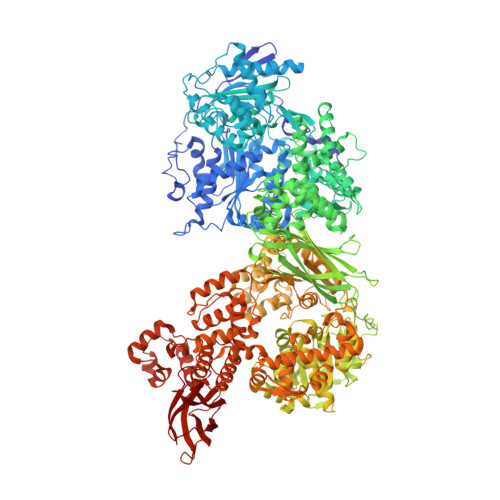Structural basis for functional cooperation between tandem helicase cassettes in Brr2-mediated remodeling of the spliceosome.
Santos, K.F., Jovin, S.M., Weber, G., Pena, V., Luhrmann, R., Wahl, M.C.(2012) Proc Natl Acad Sci U S A 109: 17418-17423
- PubMed: 23045696
- DOI: https://doi.org/10.1073/pnas.1208098109
- Primary Citation of Related Structures:
4F91, 4F92, 4F93 - PubMed Abstract:
Assembly of a spliceosome, catalyzing precursor-messenger RNA splicing, involves multiple RNA-protein remodeling steps, driven by eight conserved DEXD/H-box RNA helicases. The 250-kDa Brr2 enzyme, which is essential for U4/U6 di-small nuclear ribonucleoprotein disruption during spliceosome catalytic activation and for spliceosome disassembly, is the only member of this group that is permanently associated with the spliceosome, thus requiring its faithful regulation. At the same time, Brr2 represents a unique subclass of superfamily 2 nucleic acid helicases, containing tandem helicase cassettes. Presently, the mechanistic and regulatory consequences of this unconventional architecture are unknown. Here we show that in human Brr2, two ring-like helicase cassettes intimately interact and functionally cooperate and how retinitis pigmentosa-linked Brr2 mutations interfere with the enzyme's function. Only the N-terminal cassette harbors ATPase and helicase activities in isolation. Comparison with other helicases and mutational analyses show how it threads single-stranded RNA, and structural features suggest how it can load onto an internal region of U4/U6 di-snRNA. Although the C-terminal cassette does not seem to engage RNA in the same fashion, it binds ATP and strongly stimulates the N-terminal helicase. Mutations at the cassette interface, in an intercassette linker or in the C-terminal ATP pocket, affect this cross-talk in diverse ways. Together, our results reveal the structural and functional interplay between two helicase cassettes in a tandem superfamily 2 enzyme and point to several sites through which Brr2 activity may be regulated.
- Fachbereich Biologie/Chemie/Pharmazie, Abteilung Strukturbiochemie, Freie Universität Berlin, D-14195 Berlin, Germany.
Organizational Affiliation:

















